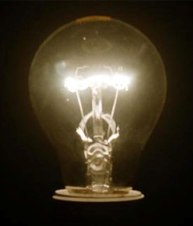Categories: Interesting Facts, Electrician Secrets, Controversial issues
Number of views: 65613
Comments on the article: 14
Why the existence of an eternal light bulb is not possible
 In the city of Livermore (California, USA) there is a unique light bulb, which was screwed in in 1901 and has since been on without interruption. This is an absolute record that entered the Guinness Book of Records. A webcam is installed in front of a unique light bulb at Fire Station No. 6, so the light bulb can be seen on the Internet. How was this possible?
In the city of Livermore (California, USA) there is a unique light bulb, which was screwed in in 1901 and has since been on without interruption. This is an absolute record that entered the Guinness Book of Records. A webcam is installed in front of a unique light bulb at Fire Station No. 6, so the light bulb can be seen on the Internet. How was this possible?
It is known that the main face of light bulb burnout is the gradual wear of a tungsten filament. This filament is heated almost to the melting point of tungsten (3300 ° C), otherwise you will not receive intense light flux. At this temperature, the tungsten atoms in the crystal lattice vibrate intensively and some of them come off and go into space, settling on the walls of the flask. Gradually, the thread becomes thinner, and in the thinnest place the temperature goes beyond the melting point, the thread burns out.
Obviously, to increase the life of the bulb, it is necessary to install a thicker thread. But at the same time, to maintain the resistance of the thread, it is necessary to increase its length. A twofold increase in the diameter of the filament leads to an increase in the mass of tungsten by 8 times. And tungsten is an expensive metal, so current light bulb manufacturers are trying to save it.
But there is another reason for lamp wear, which almost no one knows about. The fact is that thin glass of a flask in a heated state passes gas. There are tables for different glasses and different gases at different temperatures. For example, 1 cm2 of a glass surface with a thickness of 1 mm for 1 s and with a pressure difference of 1 mm Hg. passes 6.5 * 10 in (-12) degree cm3 of nitrogen at a temperature of 600 ° С (the main part of air).
Let us calculate the bulb temperature of a standard 40-watt bulb with a bulb surface area of 200 cm2 and a tungsten filament surface area of (approximately) 0.3 cm2, i.e. the difference is 660 times.
Using the calculation method according to the Stfan-Boltzmann law and taking into account that all the infrared radiation of the thread heats the flask (visible light is not more than 3%), we obtain the temperature of the flask of about 400 ° C (everyone can make sure that this is done by touching the flask glowing light bulb). Further, taking the glass thickness of the flask flask 0.5 mm, the pressure difference 760 mm RT.article. and the time is 1 year, we get the penetration of gas into the lamp about 4-5 cm.
For several years, if the filament does not burn out, the lamp will fill with gas, a gas discharge will occur, and with it the ion bombardment of the filament. Then this thread will thin out faster. Thus, in order to create an incandescent lamp with a long service life, it is necessary: to install a thick tungsten filament, increase the surface area of the lamp bulb (in this case, the bulb temperature will become lower and gas leakage will decrease), increase the glass thickness of the bulb lamp.
Obviously, these conditions were fulfilled in a long-lived lamp. And the current manufacturers do not want to fulfill these conditions, firstly, for reasons of economy (tungsten and glass), and secondly, manufacturers are simply not interested in producing “eternal” bulbs (otherwise they will “burn out”).
See also at bgv.electricianexp.com
:
